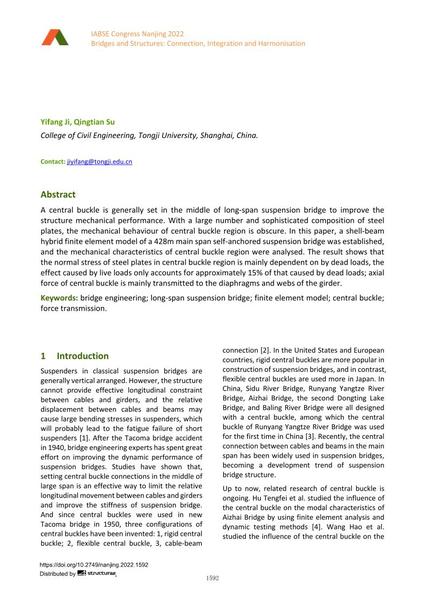Mechanical Analysis of Central Buckle Region of Long Span Suspension Bridge

|
|
|||||||||||
Bibliographic Details
| Author(s): |
Yifang Ji
(College of Civil Engineering, Tongji University, Shanghai, China.)
Qingtian Su (College of Civil Engineering, Tongji University, Shanghai, China.) |
||||
|---|---|---|---|---|---|
| Medium: | conference paper | ||||
| Language(s): | English | ||||
| Conference: | IABSE Congress: Bridges and Structures: Connection, Integration and Harmonisation, Nanjing, People's Republic of China, 21-23 September 2022 | ||||
| Published in: | IABSE Congress Nanjing 2022 | ||||
|
|||||
| Page(s): | 1592-1599 | ||||
| Total no. of pages: | 8 | ||||
| DOI: | 10.2749/nanjing.2022.1592 | ||||
| Abstract: |
A central buckle is generally set in the middle of long-span suspension bridge to improve the structure mechanical performance. With a large number and sophisticated composition of steel plates, the mechanical behaviour of central buckle region is obscure. In this paper, a shell-beam hybrid finite element model of a 428m main span self-anchored suspension bridge was established, and the mechanical characteristics of central buckle region were analysed. The result shows that the normal stress of steel plates in central buckle region is mainly dependent on by dead loads, the effect caused by live loads only accounts for approximately 15% of that caused by dead loads; axial force of central buckle is mainly transmitted to the diaphragms and webs of the girder. |
||||
| Keywords: |
bridge engineering finite element model long-span suspension bridge central buckle force transmission
|
||||
| Copyright: | © 2022 International Association for Bridge and Structural Engineering (IABSE) | ||||
| License: | This creative work is copyrighted material and may not be used without explicit approval by the author and/or copyright owner. |
||||

